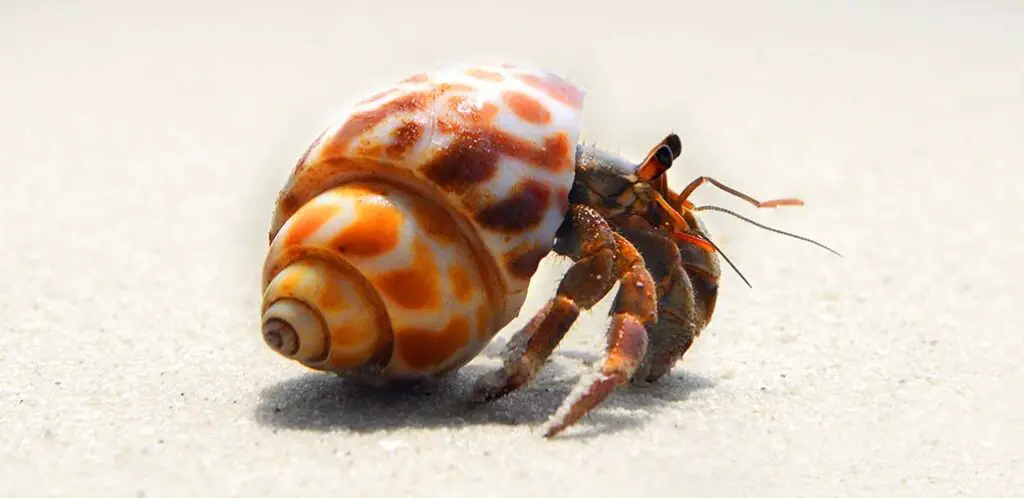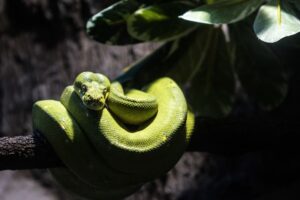Table of Contents
ToggleIntroduction
Hermit crabs are intriguing creatures well-known for their peculiar habit of inhabiting shells other animals have abandoned. These crustaceans have adapted to their complicated coastal surroundings for millions of years, allowing them to travel and survive there.
One component of their biology that has received little research attention is their vision, especially in low-light environments. The hermit crab’s eye structure, nocturnal behavior, and how they perceive their surroundings in the dark will hide in this in-depth guide to hermit crab eyesight.
Hermit Crab Anatomy And Eye Structure
Before moving on to hermit crab eyesight in dimly lit environments, it is essential to have a solid understanding of its eye structure and how it contrasts with that of other creatures.
Compound Eyes
Hermit crabs, like many crustaceans, possess compound eyes. These eyes comprise numerous small visual units called ommatidia, which work together to detect light and form images. Each ommatidium contains a lens, photoreceptor cells, and a nerve fiber. Compound eyes provide a broad field of view and are well-suited for detecting motion.
Antennal Glands
In addition to their compound eyes, hermit crabs have antennal glands on their eyestalks. These glands help maintain the moisture and cleanliness of the eye’s surface, which is essential for clear vision underwater and in terrestrial environments.
Nocturnal Behavior Of Hermit Crabs
Understanding the daily activity patterns of hermit crabs is crucial to exploring their ability to see in the dark.
Nocturnal Lifestyle
Hermit crabs are primarily nocturnal creatures, meaning they are most active at night. This behavior is considered an adaptation to avoid predators and extreme daytime temperatures.
Nighttime Foraging
Hermit crabs are nocturnal creatures that only emerge from their shells to search for food. During these nocturnal trips, they are confronted with problems in low-light circumstances; therefore, they need good vision to survive.
Lunar Influence
Some researchers believe that hermit crabs’ nocturnal behavior might be influenced by lunar cycles, as they tend to be more active during the dark phases of the moon.
Visual Adaptations For Low-Light Environments
Hermit crabs have developed several visual adaptations to navigate and forage effectively in the dark.
Increased Sensitivity
Hermit crab compound eyes are more light-sensitive than the naked human eye. This increased sensitivity allows them to detect faint light sources in low-light conditions.
Tapetum Lucidum
Many nocturnal creatures, such as some crustaceans, have a reflecting covering behind their retina called the tapetum lucidum.
This layer enhances their night vision by reflecting light through the retina, increasing the chance of photoreceptor cells detecting it.
Color Vision
While hermit crabs are not known for their color vision, they can still perceive different light shades and distinguish between varying brightness levels.
Experimental Studies On Hermit Crab Vision
Researchers have conducted various experiments to understand better how hermit crabs perceive their environment in low-light conditions.
Light Sensitivity Tests
One typical experiment involves exposing hermit crabs to different ambient light levels and monitoring their behavior. Researchers observe how hermit crabs respond to changes in light intensity and whether they can navigate obstacles in the dark.
Choice Experiments
Experiments with hermit crabs involve offering them an option between two or more objects or paths, one crafted to appear brighter or more lit than the others. The researchers examine the crabs’ decisions to gain insight into the environments in which they perceive more opportunities.
Electrophysiological Recordings
Electrophysiological recordings measure the electrical activity of the photoreceptor cells in hermit crab eyes in response to varying light conditions. These recordings help researchers understand the sensitivity and adaptability of their vision.
Vision In Different Hermit Crab Species
Hermit crabs are a diverse group with various species inhabiting different coastal environments worldwide. It’s essential to recognize that the visual abilities of hermit crabs may vary among species due to their specific adaptations to their habitats.
Terrestrial Hermit Crabs
Terrestrial hermit crabs, like the Coenobita spp., are known for their impressive climbing and navigation abilities in low-light conditions. Their vision fits the bill of terrestrial environments, where they must find food and suitable shells for shelter.
Marine Hermit Crabs
Marine hermit crabs, such as the Paguridae family, inhabit oceanic environments. Their vision may differ from terrestrial hermit crabs due to the challenges of underwater vision and the different sources of ambient light.
Factors Influencing Hermit Crab Vision
Several factors can influence hermit crab vision in low-light conditions.
Age
Like many other animals, Hermit crabs can change eyesight as they age. Younger people have more transparent and more malleable eyes than older people.
Eye Health
If a hermit crab wants to see clearly, its eyes must be in good condition. They may have trouble seeing in the dark because of illnesses or accidents.
Environmental Factors
Hermit crabs’ vision in maritime environments is sensitive to environmental conditions such as water quality and the presence of bioluminescent animals.
Species-Specific Adaptations
Different hermit crab species may have evolved specific adaptations to their unique habitats, influencing their vision abilities.
Comparing Hermit Crab Vision To Other Nocturnal Animals
It is helpful to compare the vision of hermit crabs and other nocturnal creatures to understand better their ability to see in low-light environments.
Owls
The night vision of owls is renowned across the animal kingdom. They have huge eyes with a high density of rod cells, particularly sensitive to dim light. Even though they have complex eyes, hermit crabs can sense low light levels well.
Bats
Bats utilize echolocation to find their way through the dark by making high-pitched sounds and then listening for the echoes. In contrast to bats, hermit crabs use their compound eyes to see the world around them.
Fireflies
Fireflies are bioluminescent insects that produce their light to communicate and attract mates. Hermit crabs may encounter bioluminescent organisms in their environment, adding complexity to their nocturnal vision.
Advantages Of Hermit Crabs See In The Dark
Predator Avoidance: Nocturnal vision helps hermit crabs avoid predators that are active during the night. By detecting movement and potential threats in low-light conditions, they can quickly retreat into their shells or find shelter to escape danger.
Foraging: Hermit crabs are primarily nocturnal foragers. Their ability to see in the dark allows them to locate and consume food sources that are more abundant at night, such as decaying plant matter, residue, and small prey. It helps them maintain their energy levels and nutrition.
Navigation: Hermit crabs must navigate their complex coastal environments, including rocky shores, tide pools, and sandy beaches, even in darkness. Their night vision enables them to find their way around obstacles, locate suitable shells, and move efficiently between different habitats.
Social Interaction: Hermit crabs often encounter other individuals of their species during their nocturnal activities, particularly when searching for new shells or mates. Good night vision allows them to identify and interact with conspecifics, aiding reproductive and social behaviors.
Shell Selection: When hermit crabs outgrow their current shells, they need to find new ones. The ability to see in the dark allows them to assess potential bullets during nighttime foraging expeditions, increasing their chances of finding suitable replacements.
Predator Detection: Hermit crabs are primarily herbivores and scavengers but may still encounter predatory animals at night. Their night vision helps them detect potential threats and react quickly to avoid becoming prey.
Lunar Synchronization: Researchers have come up with a theory that hermit crabs do things at night that may be on time to match the different phases of the moon. People think these actions are set to match different moon phases.
Their ability to see in low-light conditions during moonlit nights can be advantageous for coordinating activities and minimizing exposure to diurnal predators.
Energy Efficiency: Nocturnal vision allows hermit crabs to conserve energy during the day when they are less active. Being active at night can take advantage of cooler temperatures and reduce the risk of desiccation (drying out) during the daytime heat.
Increased Foraging Time: With the ability to see in the dark, hermit crabs can extend their foraging time into the night, which provides them with more opportunities to find food and resources.
Conclusion
Hermit crabs are fascinating animals to study when figuring out how animals see in the dark because of their unusual compound eyes and other adaptations for living in places with little available light. Thanks to their compound eyes, they can travel, forage, and detect potential dangers during their nocturnal activities. While they may not have the remarkable night vision of owls or the echolocation capabilities of bats, they can navigate.
Additional research into hermit crab eyesight, particularly in various species and environmental settings, can provide valuable insights into these crustaceans’ adaptations and survival tactics. Whether they live in terrestrial or marine environments, Hermit crabs have adapted over time to make the most of their eyesight capabilities. Because of this, researchers find them fascinating candidates for research in the field of nocturnal biology.







